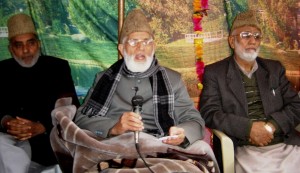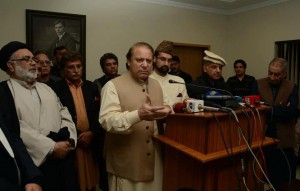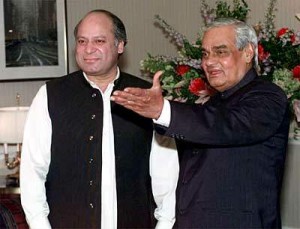Peace Watch » Kashmir-Talk » Nodding-Goat Leadership is Dangerous
Nodding-Goat Leadership is Dangerous
PUNCHLINE
Z. G. M UHAMMAD
UHAMMAD
Seventy days after there will be new government in office in New Delhi. Few days back the Shankh for one of the most thrilling electoral battles in India was blown. The elections to be held in nine phases spread over thirty-six days will be one of the long drawn battles for the Raisina Hill in the Lutyens Delhi.
Although a bit early, yet it is a big question, who will inherit throne of New Delhi – Rahul Gandhi, Narendra Modi or a surprise -first Dalit Prime Minister for India. I am not psephologist. Therefore, I am not competent enough to analyze scientifically the coming elections- use ‘historical precinct voting date,’ public opinions, campaign moods and statistical information to predict with some amount of accuracy about the results of the coming elections. If one, goes by primetime debates, analysis and verdicts on the corporate media- it is foregone conclusion that the BJP candidate Narendra Modi is the next Prime Minister.
A different question bothers me. Perhaps that might not have cropped up in the minds of even a fraction of about one billion Indian electorate. It is not going to be part of debate at the hustings nor a factor at the time of pushing the button of electronic voting machine inside the booths. Is in view of the fast changing geostrategic scenario in the South Asia and almost total withdrawal of US troops from Afghanistan at the close of the year 2014 the resolution of the Kashmir ‘dispute’/’problem’ or ‘ending of the political uncertainty’ in the state going to be a priority with the next government in New Delhi?
Historically, the resolution of the Kashmir ‘problem’ has never been part of the election manifestos of the political parties in India as has been case in Pakistan. Where Kashmir Dispute, is the most highlighted point of in the election manifestos- it was so even in 2013 elections. Nevertheless, slogans like abrogation of the Article 370 of the Indian Constitution have been part of the election campaigns of the Hindu nationalists’ parties in all their avatars and incantations.
Kashmir, true has not been the theme song with any of the political parties during past fifteen Lok Sabha elections. However, it is also a hard reality has been the central to the diplomatic engagements of New Delhi at the international level. Since 1962, the relations between New Delhi and Beijing have been bitter. Despite Beijing, claiming that all of the Arunachal Pradesh is Chinese territory for the issue being purely a problem of delineation of borders it has no international dimensions. So it has not been the cause of debate in UN Security Council nor does UN Security Council provide pedestal to this problem as is the case with Kashmir.
The case of Kashmir is altogether different from the North East. Right from November 1, 1947 when Governor Generals of newly born dominions met in Lahore for working out mechanism for allowing people to exercise, their right of choice about their future Kashmir has remained the core issue between the two countries. Despite, public posturing of calling Kashmir as an ‘integral part of India’ or pronouncing it as a ‘settled dispute’, there has been hardly any government in India right from Jawaharlal Nehru to Dr. Manmohan Singh that has not held talks with Pakistan or subtly sought third party intervention for the resolution of the dispute. Compared to the Congress the Vajpayee led government despite the BJP being prisoner of its earlier stand on Kashmir had shown enthusiasm in resolving the oldest dispute in the region and working for greater cooperation with Islamabad.
But, what has thrown blanket of scepticism on these statements or the moves has been resounding discourse in corridors in Islamabad of ‘transforming Kashmir from a point of conflict to bridge for economic cooperation between the two countries. Thinking of a “paradigm shift with a focus on the vehicle of economic interdependence’ and pronouncing this shift as being in tune with the contemporary realties’ is a dangerous approach in total conflict with the rights of Kashmiris as enshrined in the UN resolution. Cloaking the ‘step down’ in eloquent phrases like ‘conflict transformation’, or seeing concepts like ‘making borders irrelevant’ as ladder to go beyond status’ quo’ when in reality the whole idea boils down to delegitimizing the peoples struggle. Such a paradigm shift is a ‘slippery slope’. ‘The first step down this slippery slope was taken by Musharraf in December 2003 when he said publicly that Pakistan was prepared to lay aside the UN Security Council resolutions upon which Pakistan’s stand on Kashmir largely rests.’ In fact, after 2007, no effort was made to retract the steps from the slippery slope. In a very long article titled ‘Return from Kashmir’ (Published in the News on February 10 2014) Asif Ezdi, a former Pakistan diplomat has analyzed how Musharraf’s policy worked against the interests of the struggling Kashmiris and the Kashmir cause. He writes, ‘From the time Musharraf made that infamous declaration, his government also cut down its diplomatic support for the Kashmir cause. In 2004, he began back-channel negotiations with India for an ‘out-of-the-box’ settlement… Zardari could not continue the back-channel negotiations, but he continued to withdraw from Kashmir in other ways. During his presidency, the government virtually gave up its long-held position that Kashmir is the core issue’. Connecting dots Ezdi see worrisome indications in the Nawaz Government as well.
There is need to understand that after the US withdrawal from Afghanistan, India and Pakistan is bound to come on the table for hammering out a solution of the Kashmir- it will not be much of a consequence who become PM in India. In the emerging scenario, Kashmir ‘leadership’ will have to come out of the ‘nodding-goat-syndrome’ that it exhibited at Musharraf’s four-point formula. It will have to take a ‘united stand’ and not allow delegitimizing the struggle of people of Kashmir.
Filed under: Kashmir-Talk







